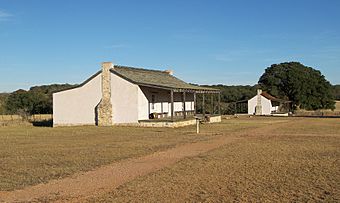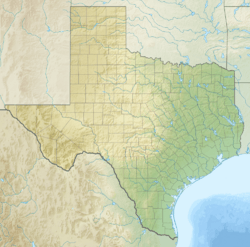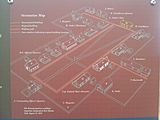Fort Martin Scott facts for kids
|
Fort Martin Scott
|
|

Restored officer quarters at Fort Martin Scott
|
|
| Nearest city | Fredericksburg, Texas |
|---|---|
| Area | 23 acres (9.3 ha) |
| Built | 1847 |
| NRHP reference No. | 80004121 |
Quick facts for kids Significant dates |
|
| Added to NRHP | January 20, 1980 |
Fort Martin Scott is a historic United States Army outpost. It is located near Fredericksburg, Texas in the Texas Hill Country. The fort was active from December 1848 until April 1853. It was part of a group of forts built to protect travelers and settlers in Texas.
Contents
Building the Fort
After the Mexican War (1846-1848), the U.S. Army built a line of seven forts. These forts were meant to protect settlers moving into West Texas. Fort Martin Scott was one of these important forts. Other forts included Fort Worth, Fort Graham, and Fort Duncan.
The fort started as Camp Houston on December 5, 1848. Soldiers from the 1st Regiment of Infantry arrived there. Over time, different army companies came and went. The camp was also called Camp Chadbourne for a short period. Later, it was known as "Camp near Fredericksburg."
The camp was located about 2 miles (3 km) southeast of Fredericksburg. It grew to have 21 buildings. Soldiers at the fort patrolled the road between Fredericksburg and San Antonio, Texas. Their main job was to protect settlers from attacks by Native American groups.
In December 1849, the camp was renamed Fort Martin Scott. It was named after Major Martin Scott. He was a brave officer who died in the Mexican War in 1847.
As more settlers moved farther west, Fort Martin Scott became less important. The army decided to close it. The fort officially closed in December 1853.
Important Treaties
Two important treaties are connected to the area around Fort Martin Scott. Treaties are agreements between different groups.
Meusebach Treaty
The Meusebach Treaty was signed on May 9, 1847. This was before Fort Martin Scott was even built. It was an agreement between the Comanche people and a German immigration company. This treaty helped keep peace between the Comanche and German settlers in a specific area of Texas.
Fort Martin Scott Treaty
The Fort Martin Scott Treaty was signed on December 10, 1850. Even though it's called the Fort Martin Scott Treaty, it was actually signed in San Saba County, Texas. It was named after the closest army fort.
This treaty was signed by an Indian agent, U.S. Army captains, and many Native American chiefs. These included chiefs from the Comanche, Caddo, Lipan, Quapaw, Tawakoni, and Waco tribes.
The treaty said that the tribes would be under the protection of the United States. It also set rules for trade. It said that no alcohol could be sold to the tribes. The tribes agreed to live in peace with each other and the U.S. government. They also promised to return any stolen property or captives.
In return, the government promised to set up trading posts. They also offered to provide blacksmiths and school teachers for the tribes. The treaty also allowed Christian preachers to visit the tribes.
After the Army Left
The Braeutigam Family
After the army left, the fort was empty for many years. In 1870, the Braeutigam family moved into the abandoned Fort Martin Scott. Johann Wolfgang Braeutigam opened a Biergarten there. A Biergarten is a type of outdoor restaurant or pub. Sadly, Johann Braeutigam was murdered in 1884 during a robbery at his business.
Fort Martin Scott Today
Today, Fort Martin Scott is a historical site. It was recognized as a Recorded Texas Historic Landmark in 1936. It was also added to the National Register of Historic Places in 1980.
The city of Fredericksburg, Texas now manages the fort. Visitors can take self-guided walking tours. Guided tours and school tours can also be arranged. The fort is located at 1606 East Main Street (Highway 290). It is open Tuesday through Sunday.
As of 2025, there are plans for a Texas Rangers Heritage Center. This center will be built next to Fort Martin Scott. It will be an educational complex. It will teach visitors about the history of the Texas Rangers, Fort Martin Scott, and Gillespie County.
Gallery
See also






